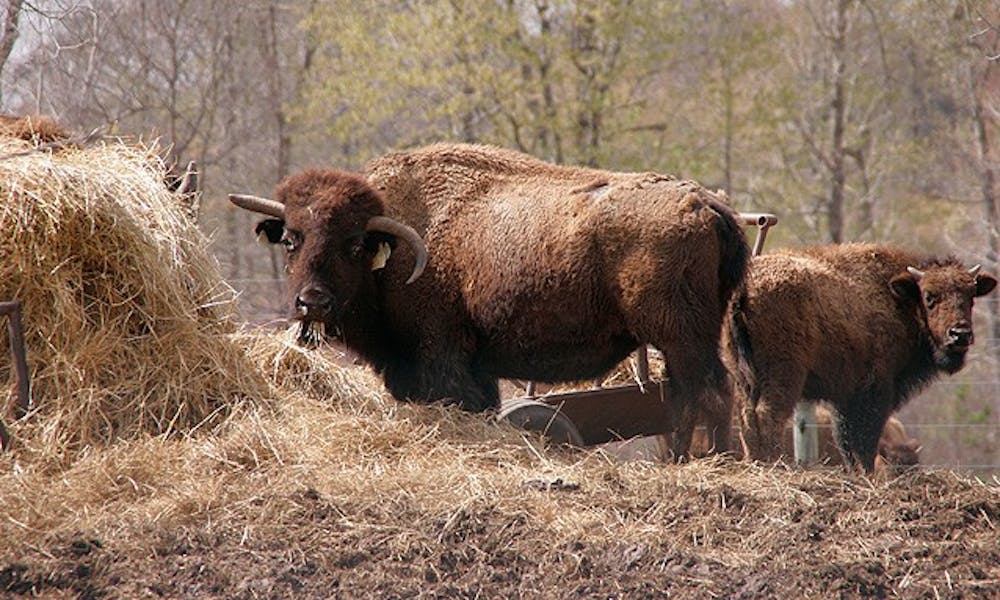Fifteen miles from Duke, buffalo roam.
Linda and Jeff Peloquin have ranched bison for six years on 80 acres at Hillsborough’s Vista Wood Bison Ranch, and they have more orders for meat than they can fill because chefs have recently begun to prize bison as an alternative to beef. Although buffalo is more expensive at about $7 per pound, it’s a healthier meat with more protein and considerably less fat per ounce. Bison cuts show no marbling, cook quickly and taste just like good beef. The Peloquins sell to family and friends, have a table at the Durham Farmers Market and supply a few local vendors and restaurants.
“It’s America’s original and best product of meat. We wanted a super-healthy and natural product we could sell from the farm,” Linda said. “Buffalo’s the healthiest red meat and it’s indigenous to North Carolina—unlike cattle.”
But wild buffalo have not been seen east of the Mississippi since 1820.
“They were the staple food and shelter source for the Native American Indians in the early 20th century,” Jeff said. “They were so many that they literally filled the landscape.”
Although the Peloquin’s herd lives behind fences, they are wild animals like their ancestors. Once, a buffalo charged Jeff inside the pen, accelerating to a full gallop before abruptly stopping in front of him, horns inches away. Jeff promptly punched the cow hard between the eyes; she then staggered in retreat.
Since then, he’s only gone into the enclosure on a Bobcat or a four wheeler. The muddy ground around the fence is scored with tractor ruts, and I stand in one about twenty feet from the wires as one of the larger females notices and breaks towards me—tail snapping, head thrown back. Jeff pulls me to him by the shoulder and she stops and paces back and forth at the wire, snorting and snarling.
“They could easily jump over or run through the electric fence,” Linda told me. “But they want to stay with the herd, which has all it needs inside.”
Next, Jeff shows me the bison squeeze, a device that accomplishes the difficult task of separating individuals from the herd. It’s a circular pen with one side open to the pasture. When the buffalo enter to feed on the grain inside, a swinging arm forces them into a chute. At the end is a small cage from which the bison can be released one at a time to medical treatment, sale or slaughter. The Peloquins use a slaughterhouse that reclaims 40 percent of an animal’s weight as ground meat and steak, Jeff said.
They gave me a pound of shrink-wrapped bison sausage before I left, dark red with sage leaves and no discernible streaks of fat. I fried it up in Wannamaker’s basement kitchen late that night—it was delicious.
But the Peloquins don’t simply consider their bison commodities.
They look each other in the eyes when they tell me about Houdini. He was a massive 3,000-pound stud bull who could open fences and was the only buffalo they’d ever named.
“We went inside the fence. The females were very upset, and he knew that he had to go into the chute. And Houdini just sat on the ground. And he was crying. You could see tears running from his eyes,” Linda told me.
One year, a calf died. The Peloquins buried her in the pasture. And after they left, the bison circled the burial site for a day and a night, heads hung in mourning, Linda said.
But the herd knows life as well as death. Each year, late in the spring, females softly enter the woods alone on the far side of the pen. After leaving the pasture, cows do not allow themselves to be seen, but Jeff and Linda like to guess what happens. They like to believe that she finds a place where the wind is broken. They like to believe that there she delivers a calf and licks its eyes open. They like to believe that the two conserve their strength together until they both can stand.
And then, days later, the couple sees a mother emerging from the forest, nudging her child gently to the center as the herd surrounds them in welcome.
They hope for seven calves this spring.
Get The Chronicle straight to your inbox
Signup for our weekly newsletter. Cancel at any time.

